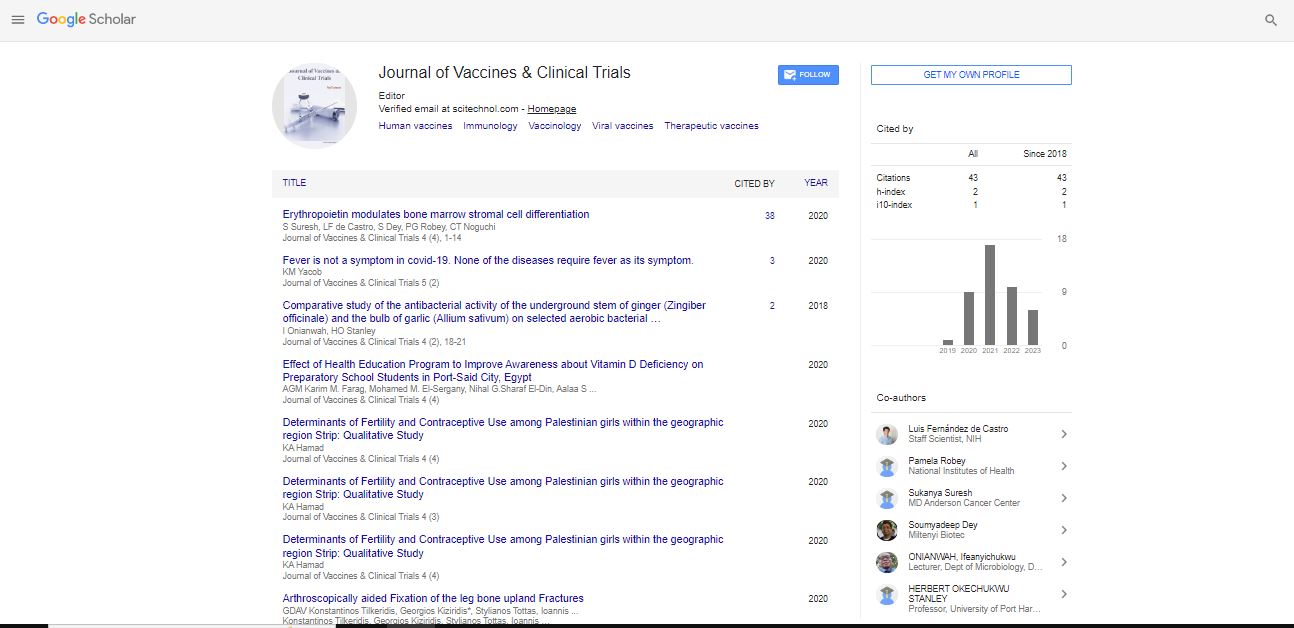Perspective, Jou Of Vac Cli Tr Vol: 7 Issue: 2
Insights the Efficacy Aid Immune of Vaccines in Multilayer Network in the Body
Natalie Fuad*
1National Center for Immunization and Respiratory Diseases, Centers for Disease Control and Prevention, Atlanta, Georgia
*Corresponding Author: Natalie Fuad,
National Center for Immunization and
Respiratory Diseases, Centers for Disease Control and Prevention, Atlanta,
Georgia
E-mail: Fuadtalie22@hotmail.com
Received date: 29 May, 2023, Manuscript No. JVCT-23-102765;
Editor assigned date: 31 May, 2023, PreQC No. JVCT-23-102765(PQ);
Reviewed date: 14 June, 2023, QCNo JVCT-23-102765;
Revised date: 21 June, 2023, Manuscript No. JVCT-23-102765(R);
Published date: 28 June, 2023, DOI: 10.4172/JVCT.100076
Citation: Fuad N (2023) Insights the Efficacy Aid Immune of Vaccines in Multilayer Network in the Body. Jou of Vac Cli Tr 7:2.
Description
The efficacy and effectiveness of vaccines are influenced by the complex dynamics of their spread within the body's multilayer networks. This study aims to provide insights into how vaccines spread through these interconnected networks and the factors that influence their distribution and impact. We explore the immune response, the role of various tissues and organs, and the interplay between different layers of the immune system. Understanding the dynamics of vaccine spread within multilayer networks can contribute to optimizing vaccination strategies and improving public health outcomes.
Vaccination is a fundamental strategy in preventing the spread of infectious diseases. The effectiveness of vaccines relies on their ability to spread through interconnected networks within the body, consisting of various tissues, organs, and immune cells. This study aims to elucidate the mechanisms and dynamics of vaccine spread within multilayer networks and their implications for immune response and protection. Understanding these complex processes can inform the development of more effective vaccination strategies and optimize the control of infectious diseases.
Multilayer networks and the immune system
The immune system consists of multiple layers of defense mechanisms that work together to protect the body from pathogens. These layers include physical barriers, innate immune responses, and adaptive immune responses. Multilayer networks within the body represent the interconnectedness between different tissues, organs, and immune cells, enabling the spread of vaccines and the subsequent immune response.
Vaccine administration and distribution
The administration of vaccines initiates the process of vaccine distribution within multilayer networks. Different vaccination routes, such as intramuscular, subcutaneous, or intranasal, influence the distribution patterns and speed of vaccine spread. Vaccines can directly target specific tissues or organs, while others generate systemic responses.
Vaccine spread and immune response
Once vaccines are administered, they interact with various components of the immune system, initiating immune responses at multiple layers. Antigen-presenting cells capture and process vaccine antigens, presenting them to specific immune cells, such as T cells and B cells. These cells migrate through the bloodstream and lymphatic system, interacting with lymphoid tissues and organs, such as lymph nodes and spleen, where they initiate immune responses and generate memory cells.
Interplay between immune system layers
The spread of vaccines within multilayer networks involves intricate interactions between different layers of the immune system. For example, dendritic cells capture vaccine antigens in peripheral tissues and transport them to lymph nodes, where they activate T cells and B cells. These activated cells then migrate back to peripheral tissues to eliminate infected cells and provide localized immune protection. This interplay between layers is important for the coordination and effectiveness of the immune response.
Factors influencing vaccine spread in multilayer networks
Several factors can influence the spread of vaccines within multilayer networks. These include vaccine characteristics (e.g., antigen stability, adjuvants), host factors (e.g., immune status, genetic variability), and environmental factors (e.g., microbial composition, tissue-specific factors). Understanding these influences can aid in optimizing vaccine formulations, administration routes, and vaccination strategies.
Implications for vaccination strategies
Understanding the dynamics of vaccine spread within multilayer networks provides insights for improving vaccination strategies. Targeting specific layers or tissues may be advantageous for achieving local immunity, while systemic vaccine spread is important for generating widespread protection. Considering interplay between immune layers can help optimize timing and dosing of booster vaccinations and promote the development of robust and long-lasting immune memory.
Conclusion
The spread of vaccines within multilayer networks in the body is a complex process that influences immune responses and ultimately determines vaccine efficacy. Understanding these dynamics is vital for developing effective vaccination strategies and improving public health outcomes.
 Spanish
Spanish  Chinese
Chinese  Russian
Russian  German
German  French
French  Japanese
Japanese  Portuguese
Portuguese  Hindi
Hindi 